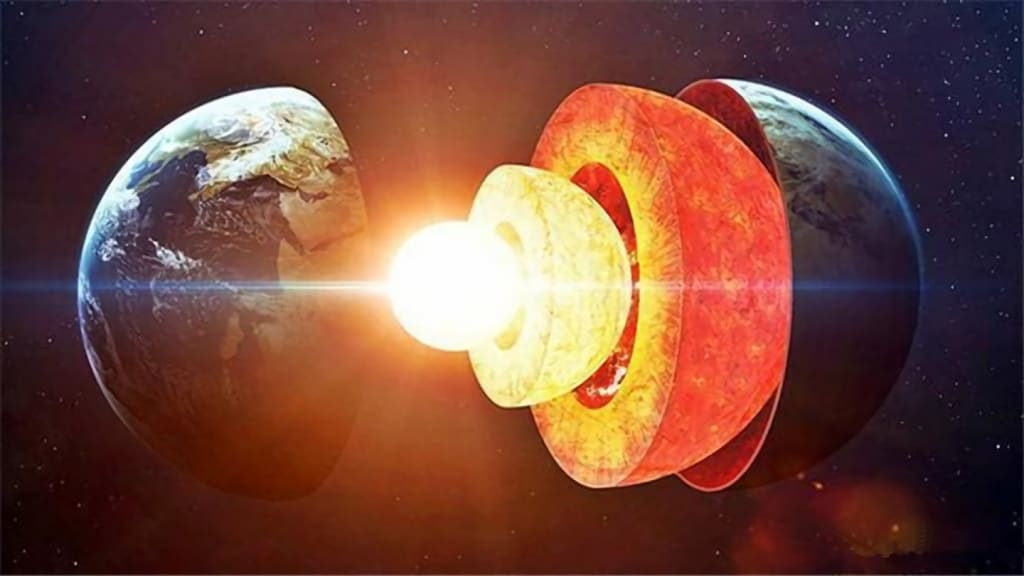Scientists have discovered a hidden new world in the earth's core, and we have to re-understand the earth
We're going to get to know the earth again

Scientific researchers have discovered in the Earth's core that the Earth's "solid" inner core may actually be a bit mushy, and we may have to re-understand this hidden new Earth.
Earth is the homeland of human beings. Since ancient times, people have dreamed of knowing what the world they lived in was like.
The scientific community has long believed that Earth's inner core is a solid sphere of compressed iron alloy surrounded by a liquid outer core.
But researchers have now discovered that Earth's "solid" inner core may actually be a bit mushy.
So they show in the journal "Physics of the Earth and Planetary Interiors," published on September 20, that planetary balls range in hardness from hard metals to semi-soft metals to liquid metals.
Earth's core
Earth has a silicon-rich crust, a very viscous mantle, a liquid outer core and a solid inner core. The formation mechanism and existence form of this solid-state structure have always been things that scientists want to understand.
But for the interior of the earth, we have never been able to go deep into it to really detect it at close range, so how do scientists understand the interior of the earth?
In fact, these understandings of the internal structure of the earth come from physical evidence and some inferences, which include material from volcanoes and seismic waves.
We all know that there are many volcanic activities on the earth, and plate movement can also bring earthquakes.
Volcanoes pass through the mantle layer, and the magma in them is ejected from the crater. Scientists can gain an initial understanding of the mantle layer by studying these volcanic leaks.
Earthquakes caused by plate motion create seismic waves. This is the most important way for scientists to understand the overall structure of the earth. When seismic waves travel through different materials, they create different fluctuations. These fluctuating data are simulated by computer manipulation. It is possible to have a general understanding of the Earth's interior.
According to the changes of seismic waves, it is found that the earth's core also has an outer core and an inner core. Since the shear waves of seismic waves cannot pass through the outer core, it is generally speculated that the outer core is composed of molten or near-liquid substances composed of iron, nickel, silicon and other substances. Since the shear waves exist in the inner core, the inner core should be solid.
This is an understanding of the earth's core by scientists in the past through seismic waves. These understandings are not comprehensive. There is still a lot of controversy in the academic community about the material composition of the inner core. Many people believe that it is mainly composed of iron and nickel.
But what is it, all this remains to be further explored and proved. In addition, the inner and outer cores are not completely separated. The core is so dense that even the hardest diamonds are pressed to a buttery softness here.
In some ways, the Earth's inner core is still as mysterious as Jules Verne's "Journey to the Center of the Earth," published in 1864.
Reason for research
For Rhett Butler, a geophysicist at the Institute of Geophysics and Planetary Sciences in Hawaii, the new study began with a number mismatch.
Butler is studying how seismic waves from large earthquakes at five different locations travel through the Earth's core to the other side of the planet.
But something happened, and he found that the shear waves of the earthquake, which were supposed to pass through a solid metal ball, were deflected in certain areas.
Those numbers surprised Butler. Because he knew that the seismic wave math was correct, then that could mean just one thing, that something went wrong with the structure of the scientist.
Geophysicists rely on more seismic wave data from measuring earthquakes to reconstruct images of the inner workings of planets in a manner similar to human CT scans.
It turned out that these waves mainly come in the form of straight-line compression waves and undulating shear waves, each of which can be accelerated, decelerated or bounced off a different medium as it travels through the ground.
"When you're in this business, you have to match the data," Butler said. So Butler and his co-authors reassessed their basic assumption that Earth's inner core was always solid.
They found that the waves they observed would work if the core wasn't a solid sphere, but had liquid and "mushy" semi-solid iron near its surface. "We're seeing evidence that not only is it not soft everywhere, it's really hard in places, and it has a hard surface against molten or mushy iron," Butler said. The range is especially amazing, so now we're seeing a lot of detail in the kernel that we haven't seen before."
"The more we looked, the more we realised it wasn't a boring mass of iron," Jessica Owen, a seismologist at the University of Bristol, UK, who was not involved in the study, told LiveScience. world."
Find a new world
Scientists have always believed that the interior of the earth is a very unstable world, because various substances inside the earth are always in constant motion.
The research could also revolutionize our understanding of Earth's magnetic field, according to a 2019 publication in the journal Science Advances.
The magazine says that while the rotating liquid outer core drives our planet's magnetic field, the inner core helps to change the magnetic field.
Other planets, such as Mars, have a liquid center but lack a core and magnetic field, according to NASA research.
So Butler and Owen believe that a deeper understanding of the inner core will help scientists understand the relationship between a planet's interior and its magnetic activity.
"The interior of the planet remains unexplored right now because its enormous heat and pressure are too great for any human or man-made probe," Owen said. "Unless something really terrifying happens to our planet, we'll never be able to directly observe it." Earth's core.".
It is hoped that our future technology will develop to this stage as soon as possible, and develop high-temperature materials with a temperature resistance of more than 5,000 degrees Celsius, allowing people to go to the core to explore and discover a series of secrets of the earth.
About the Creator
sayre laylah
Tired of monotonous climbing moves, but every step is close to the top
Enjoyed the story? Support the Creator.
Subscribe for free to receive all their stories in your feed. You could also pledge your support or give them a one-off tip, letting them know you appreciate their work.






Comments
There are no comments for this story
Be the first to respond and start the conversation.